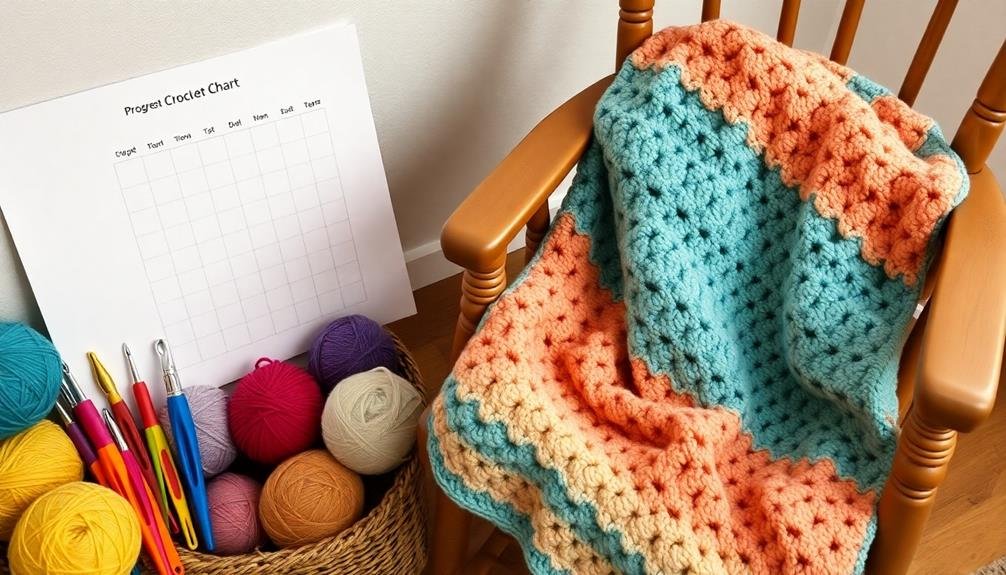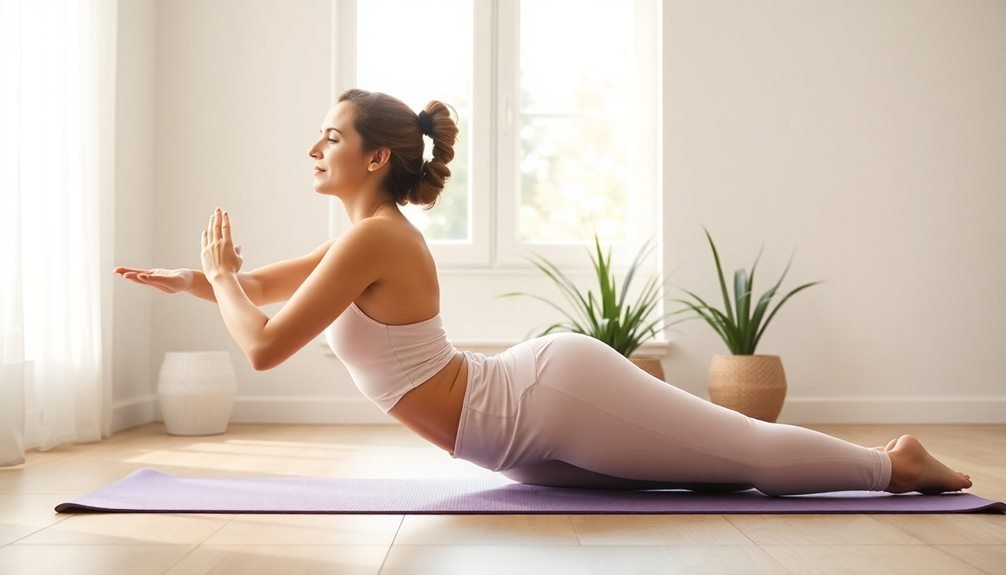Ease your anxious mind while crocheting with these 10 progress trackers. Try digital stitch counter apps for convenience, or opt for printed tracking sheets for a tactile experience. Bullet journal crochet pages offer creative customization, while row counter bracelets keep you focused. Crochet project planner notebooks help manage multiple works-in-progress. Visual yarn usage trackers and time-based charts provide satisfying progress visuals. Pattern-specific progress grids keep complex projects organized. Mindfulness-focused crochet journals combine crafting with self-reflection. Finally, explore crochet project planner notebooks for thorough project management. These tools not only track your progress but also enhance your overall crochet experience, offering peace of mind and organization.
Digital Stitch Counter Apps

Digital stitch counter apps offer a modern solution for crocheters to track their progress. These apps transform your smartphone into a powerful tool for managing complex patterns and keeping count of your stitches. You'll find a variety of options available on both iOS and Android platforms, each with unique features to suit different crocheting styles.
Most digital stitch counters allow you to create multiple projects, set row counts, and track stitch increases or decreases. Some advanced apps even let you import patterns, set timers, and calculate yarn usage. You'll appreciate the convenience of having all this information at your fingertips, especially when working on intricate designs.
Many apps offer customizable interfaces, allowing you to adjust fonts, colors, and layouts to your liking. Some include helpful extras like built-in calculators for gauge swatches or hook size converters. You can often sync your progress across devices, ensuring you're always up-to-date, whether you're crocheting at home or on the go.
While there's a learning curve to using digital counters, they can greatly reduce errors and anxiety in your crochet projects. They're particularly useful for multitaskers who need to pause and resume projects frequently.
Printed Progress Tracking Sheets
While digital apps offer high-tech solutions, many crocheters prefer the tactile experience of printed progress tracking sheets. These sheets allow you to physically mark your progress, providing a tangible sense of accomplishment.
You'll find a variety of printable templates online, ranging from simple row counters to more elaborate designs that track multiple projects simultaneously.
When using printed sheets, you'll appreciate the ability to see your entire project at a glance. You can easily note pattern repeats, color changes, and stitch modifications without relying on battery life or internet connectivity.
Plus, you'll have a permanent record of your work, which can be helpful for future projects or when sharing patterns with fellow crafters.
Some benefits of using printed progress tracking sheets include:
- Customization options to fit your specific project needs
- Ability to make quick notes or sketches directly on the sheet
- No risk of losing data due to technical glitches or app updates
To get started, search online for free printable crochet tracking sheets or create your own using spreadsheet software.
You'll soon discover how these analog tools can help ease your anxious mind and keep your crochet projects organized and on track.
Bullet Journal Crochet Pages
Creativity meets organization in bullet journal crochet pages. These customizable spreads allow you to track your crochet projects while indulging in artistic expression. You'll find endless possibilities for designing pages that suit your unique needs and preferences.
Start by dedicating a section of your bullet journal to crochet. Create an index page to easily locate your project logs, stitch libraries, and yarn inventories. Design project pages with space for pattern details, yarn information, hook size, and progress notes. Include mini calendars to mark start and completion dates, helping you visualize your crafting journey.
Incorporate mood trackers alongside your crochet logs to monitor how your projects impact your emotional well-being. Use color-coding systems to categorize projects by difficulty, size, or recipient. Add sketches of your finished items or attach small swatches for a tactile element.
Don't forget to include pages for your crochet goals, wish lists, and gift ideas. Create habit trackers to monitor daily crocheting time and celebrate your consistency.
With bullet journal crochet pages, you'll have a personalized, all-in-one system to manage your projects and soothe your anxious mind.
Row Counter Bracelets
For crocheters on the go, row counter bracelets offer a stylish and practical solution to tracking progress. These wearable devices combine fashion with functionality, allowing you to keep count of your rows without interrupting your workflow.
You'll find various designs available, from simple beaded bracelets to more elaborate digital counters that attach to your wrist.
To use a row counter bracelet, simply slide a bead or press a button after completing each row. This tactile method helps you stay focused on your project while maintaining an accurate count. Many crocheters find these bracelets particularly useful for complex patterns or when working in distracting environments.
Some benefits of row counter bracelets include:
- Portability: Wear them anywhere, anytime
- Versatility: Use them for various crochet projects
- Convenience: No need for separate counters or notepads
When choosing a row counter bracelet, consider factors like durability, ease of use, and comfort. Opt for adjustable designs to guarantee a proper fit.
With a row counter bracelet, you'll never lose track of your progress again, allowing you to crochet with confidence and ease your anxious mind.
Crochet Project Planner Notebooks

Crochet project planner notebooks offer an all-encompassing way to manage your crafting endeavors.
You'll find dedicated sections to organize multiple works in progress (WIPs), keep tabs on your yarn inventory, and document any pattern modifications you make along the way.
These notebooks serve as a centralized hub for all your crochet project information, helping you stay organized and efficient in your crafting pursuits.
Organize Multiple WIPS
With multiple works-in-progress (WIPs) on the go, it's easy to lose track of your crochet projects. Organizing your WIPs is essential for maintaining momentum and reducing stress. A dedicated system for managing multiple projects will help you stay focused and motivated.
To effectively organize your WIPs, consider using a combination of physical and digital tools. Create a central hub where you can store all project-related information, including patterns, yarn details, and progress notes. This could be a binder, a digital spreadsheet, or a specialized crochet project management app.
Here are some key elements to include in your WIP organization system:
- Project status tracker: Record the current stage of each project
- Supplies inventory: Keep track of yarn and notions for each WIP
- Time estimates: Note how much time you've spent and how much is left
Track Yarn Inventory
An integral part of organizing your crochet projects is keeping tabs on your yarn inventory. Your crochet project planner notebook can be an excellent tool for this purpose.
Create a dedicated section to track your yarn stash, including details like brand, color, fiber content, weight, and yardage. You'll also want to note how many skeins or balls you have of each type.
As you use yarn for projects, update your inventory accordingly. This practice helps you avoid overbuying and guarantees you always know what's available.
Include a wishlist section for yarns you'd like to acquire, which can be handy when you're shopping or receiving gifts.
Consider adding a color swatch page to your planner. Attach small samples of each yarn you own, making it easier to visualize color combinations for future projects.
You can also include notes about where you purchased the yarn and its price, which is useful for budgeting and reordering.
Record Pattern Modifications
Three key reasons make recording pattern modifications essential in your crochet project planner notebook. First, it helps you remember changes you've made, ensuring consistency throughout your project.
Second, it allows you to replicate successful modifications in future projects.
Third, it's a valuable resource when sharing your work with others or creating your own patterns.
To effectively record pattern modifications, use clear and concise notes. Write down specific stitch counts, yarn weights, and hook sizes you've altered. Include sketches or diagrams if they help illustrate your changes.
Don't forget to note the reasons behind your modifications, as this context can be significant for future reference.
Consider using these elements in your pattern modification records:
- Before and after comparisons
- Step-by-step instructions for complex changes
- Photos of swatches or finished sections
Stitch Marker Progress Rings
Stitch marker progress rings offer you an easy visual way to track your crochet project's advancement.
You'll find these small, removable markers incredibly helpful for counting rows or marking specific stitch locations.
Easy Visual Tracking
For an effortless way to track your crochet progress, stitch marker progress rings are a game-changer. These simple yet effective tools provide easy visual tracking, allowing you to quickly see how far you've come in your project. You'll no longer need to count stitches or rows constantly, reducing frustration and saving time.
Stitch marker progress rings come in various colors and styles, making it easy to customize your tracking system. You can use different colors to represent specific milestones or patterns in your work.
Here's how they can help you:
- Instantly visualize your progress at a glance
- Eliminate the need for frequent counting
- Easily identify pattern repeats or sections
To use these rings, simply attach them to your work at predetermined intervals. As you crochet, you'll see the rings move up your project, providing a clear visual representation of your progress.
This method is particularly useful for larger projects or intricate patterns where it's easy to lose track of your place. With stitch marker progress rings, you'll feel more confident and organized in your crochet journey, allowing you to focus on the joy of creating.
Customizable Color Coding
One of the most versatile features of stitch marker progress rings is their customizable color coding system. You can assign specific colors to different project elements, making it easy to track multiple aspects simultaneously. For example, you might use red markers for row counts, blue for pattern repeats, and green for increases or decreases.
This color-coded approach allows you to:
| Track Progress | Identify Patterns | Spot Errors |
|---|---|---|
| Count rows | Recognize repeats | Find missed stitches |
| Monitor length | Mark sections | Detect inconsistencies |
| Gauge timing | Highlight details | Pinpoint corrections |
By using different colors, you'll quickly interpret your progress at a glance. You can even create a personal color key, tailoring it to your specific project needs. This system is particularly helpful for complex patterns or when working on multiple projects simultaneously.
Don't hesitate to experiment with various color combinations to find what works best for you. You might discover that certain hues are more visually striking or easier to differentiate in different lighting conditions. Remember, the goal is to create a system that reduces your anxiety and enhances your crocheting experience.
Visual Yarn Usage Trackers

Colorful diagrams and visual representations offer an intuitive way to track yarn usage in crochet projects. You'll find these trackers especially helpful when working with multiple colors or managing limited yarn supplies. By creating a visual chart, you can easily monitor how much of each color you've used and how much remains.
To implement a visual yarn usage tracker, you might:
- Draw a simple bar graph, with each bar representing a different yarn color
- Use a pie chart to illustrate the proportions of various colors in your project
- Create a grid system where you color in squares as you use up yarn
These visual aids not only help you stay organized but also provide a satisfying sense of progress as you work. You'll be able to see at a glance how close you're to completing your project or if you need to restock certain colors.
Plus, they're customizable to fit your specific project needs. Whether you're working on a complex pattern or a simple scarf, visual yarn usage trackers can help ease your anxious mind by giving you a clear picture of your progress and resource management.
Time-Based Crochet Tracking Charts
While visual yarn trackers focus on materials, time-based crochet tracking charts shift attention to the hours you spend on your project. These charts help you monitor your progress by logging the time invested in each session or day. You'll find various formats, from simple spreadsheets to elaborate bullet journal layouts.
To create your own time-based chart, start by deciding on your preferred time unit: hours, 30-minute blocks, or even 15-minute intervals. Then, set up a grid with dates on one axis and time units on the other. As you crochet, fill in the cells to represent your work sessions.
You can enhance your chart by color-coding different project sections or using symbols to mark milestones. Some crocheters include a daily goal line to visualize their progress against expectations.
Don't forget to leave space for notes about challenges or breakthroughs.
Pattern-Specific Progress Grids

Pattern-specific progress grids offer you tailored solutions for tracking your crochet projects.
You'll find customizable row counters that adapt to complex patterns, allowing you to mark off each completed row with ease.
Visual stitch tracking features enable you to monitor intricate stitch combinations, ensuring you stay on course throughout your project.
Customizable Row Counters
Crafters seeking a tailored approach to tracking their crochet projects will find customizable row counters invaluable.
These versatile tools allow you to create a personalized tracking system that fits your specific pattern and working style. Unlike pre-made trackers, customizable row counters give you the freedom to adjust the layout, add notes, and incorporate pattern-specific elements.
To create your own row counter, start with a blank grid or notebook. Customize it by adding columns for:
- Row numbers
- Stitch counts
- Pattern repeats or special instructions
You can also include space for notes on color changes, increases, or decreases. As you work through your project, simply mark off completed rows or add tally marks to keep track of your progress.
Customizable row counters are particularly useful for complex patterns or when you're working on multiple projects simultaneously. They help you stay organized and focused, reducing the likelihood of mistakes and the need to frog your work.
Visual Stitch Tracking
Designed for visual learners, pattern-specific progress grids offer a unique way to track your crochet work. These grids are tailored to specific patterns, allowing you to mark off completed stitches, rows, or sections as you progress. You'll find them especially useful for complex patterns with multiple stitch types or color changes.
To use a progress grid, you'll typically print out a chart that represents your pattern. As you crochet, you'll color in or mark off each completed stitch or section. This visual representation helps you quickly identify where you're in the pattern and what's coming next. It's particularly helpful when you need to put your project down and pick it up later, as you can easily see where you left off.
Many crocheters create their own progress grids using graph paper or digital tools. You can customize these grids to include color coding for different stitches or sections of your pattern. Some even incorporate symbols or icons to represent specific techniques.
Mindfulness-Focused Crochet Journals
Mindfulness-focused crochet journals blend the meditative aspects of crochet with intentional self-reflection.
These journals encourage you to pause and consider your emotions, thoughts, and physical sensations as you work on your crochet projects. By incorporating mindfulness practices into your crochet routine, you'll deepen your awareness and enhance the stress-relieving benefits of your craft.
A typical mindfulness-focused crochet journal might include prompts that guide you to:
- Notice the texture and color of your yarn as you work
- Observe your breathing and body posture while crocheting
- Reflect on any emotions or thoughts that arise during your crochet session
As you consistently use a mindfulness-focused crochet journal, you'll develop a stronger connection between your crafting and your inner world.
This practice can help you identify patterns in your thoughts and emotions, leading to greater self-awareness and emotional regulation.
You'll also likely find that your crochet projects become more enjoyable and meaningful as you approach them with heightened mindfulness.
Frequently Asked Questions
How Can Crochet Progress Tracking Help Manage Stress and Anxiety?
You'll find crochet progress tracking calms your mind by providing tangible evidence of your accomplishments. It's a visual reminder of your skills and growth, helping you stay focused and reducing stress as you see your project evolve.
Are There Eco-Friendly Options for Crochet Progress Tracking Tools?
You'll find many eco-friendly options for tracking your crochet progress. Try using recycled paper notebooks, biodegradable counters, or digital apps on your device. You can also repurpose household items like pebbles or buttons as row markers.
Can Progress Trackers Be Used for Knitting and Other Fiber Arts?
You can definitely use progress trackers for knitting and other fiber arts. They're versatile tools that help you keep tabs on your projects, regardless of the craft. You'll find them useful for tracking rows, stitches, and patterns in various crafts.
What's the Best Tracking Method for Beginners Learning Complex Crochet Patterns?
You'll find row counters and digital apps most helpful as a beginner with complex patterns. They're easy to use and keep you on track. Don't forget to mark your pattern and take progress photos too.
How Do I Choose the Right Progress Tracker for My Crochet Skill Level?
To choose the right progress tracker, assess your skill level honestly. Start with simple row counters if you're a beginner. As you advance, try stitch markers or digital apps. Match the tracker's complexity to your pattern's difficulty.
In Summary
You've now got a variety of tools to keep your crochet projects organized and your mind at ease. Whether you prefer digital apps, bullet journals, or physical trackers, there's an option that'll suit your style. Remember, these progress trackers aren't just about monitoring your work; they're also about celebrating your achievements and mindful crafting. So pick a method that resonates with you, and you'll find your crochet journey becomes more enjoyable and less anxiety-inducing.





Leave a Reply